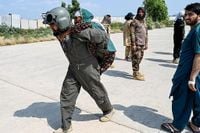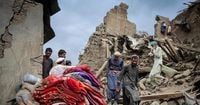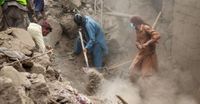In the early hours of Sunday, August 31, 2025, a devastating magnitude 6.0 earthquake struck the mountainous regions of eastern Afghanistan, unleashing destruction on a scale the country has not seen in years. Centered near the provinces of Kunar and Nangarhar and at a shallow depth of just 10 kilometers (6 miles), the quake was quickly followed by a second tremor—measured at magnitude 5.2 by some agencies and 5.5 by others—on Tuesday, September 2. These back-to-back disasters have left Afghanistan reeling, with more than 1,400 people confirmed dead, over 3,000 injured, and entire villages razed to the ground.
According to Afghanistan’s Taliban administration, the death toll currently stands at 1,411, with 3,124 people injured and more than 8,000 homes destroyed. The vast majority of casualties have been reported in Kunar province, though the neighboring provinces of Nangarhar and Laghman have also suffered significant losses. The United Nations and other international agencies warn that these numbers could rise further, as many victims remain trapped under the rubble and some remote communities are still cut off by landslides and blocked roads.
Rescue operations have been hampered by the region’s formidable geography. The Hindu Kush mountains, where the Indian and Eurasian tectonic plates meet, are notorious for their seismic activity. Since 1950, the area within 150 miles of the latest quake has experienced 71 earthquakes of magnitude 6 or higher, including six that reached magnitude 7 or above, as reported by the U.S. Geological Survey. The most recent disaster was caused by thrust faulting in these unstable mountains, which had already been left vulnerable by days of heavy rain.
In the immediate aftermath, search and rescue teams—comprising local volunteers, military personnel, and international aid workers—rushed to reach survivors. But the challenges were immense. Landslides triggered by the tremors blocked access to isolated villages, and many communities remained out of reach for days. In some of the hardest-hit areas, such as Kunar’s Nurgal district, victims were still trapped under debris on Wednesday, with local official Ijaz Ulhaq Yaad telling AFP, “There are some villages which have still not received aid.”
To overcome the impassable terrain, Afghan authorities airdropped dozens of commando forces into mountainous zones where helicopters could not land, according to Ehsanullah Ehsan, head of disaster management in Kunar. "A camp has been set up where service and relief committees are coordinating supplies and emergency aid," Ehsan said, as quoted by Reuters. Two additional centers were established to oversee the transfer of the injured, burial of the dead, and the rescue of survivors.
The Ministry of Defence reported organizing 155 helicopter flights over two days, evacuating around 2,000 injured people and their families to regional hospitals. More than 40 additional flights have transported the wounded from Nangarhar’s airport, with images shared by the Ministry showing victims carried on stretchers through the chaos of the rescue effort.
International organizations have mobilized quickly, but resources remain painfully limited in a country of 42 million already battered by decades of war, endemic poverty, and recent aid cuts. Médecins Sans Frontières (Doctors Without Borders) distributed trauma kits at two hospitals in the affected area, but the needs far outstrip the available supplies. "We saw many patients treated in the corridors and health workers in need of supplies," said Dr. Fazal Hadi, the group’s deputy medical coordinator in Afghanistan, in comments to Reuters. Hospitals were working at full capacity even before the quake struck, and the influx of casualties has pushed them to the brink.
The World Food Programme, the world’s largest humanitarian organization, announced it was "rushing food to affected communities in eastern Afghanistan," specifically delivering high-energy biscuits and deploying mobile storage units to support the broader emergency response. The British Red Cross reported that its trained volunteers were assisting in search and rescue missions and distributing essentials like food and drinking water to those affected.
Save the Children, which has a long history of working in Afghanistan, sent health teams to treat children and families in quake-hit areas, provided clean water, and distributed materials for temporary shelters, hygiene kits, and education supplies. One of its aid teams had to walk 20 kilometers (12 miles) to reach villages cut off by rockfalls, carrying medical equipment on their backs with the help of local residents.
Other charities, such as Afghan Relief, have teams on the ground "working tirelessly to deliver emergency food, water, medical aid and shelter to those affected," according to their statements. The United Nations Office for the Coordination of Humanitarian Affairs (OCHA) called for an urgent scale-up of the humanitarian response, emphasizing the need for emergency shelter, food, sanitation, drinking water, and critical medical supplies.
The international community has pledged support, but Afghanistan’s political situation complicates the delivery of aid. Major donors, including the United States, have reduced assistance since the Taliban returned to power in 2021. The United Kingdom pledged £1 million (about $1.3 million) to be split between humanitarian agencies, deliberately bypassing the Taliban government, which it does not recognize. The European Union is sending 130 tonnes of emergency supplies and providing €1 million ($1.16 million). The United Arab Emirates, India, and China have also committed disaster relief aid. The United Nations released $5 million from its emergency fund, matched by another $5 million from the Afghanistan Humanitarian Fund, to kickstart the response.
Despite these efforts, hope is fading for those still trapped. Survivors describe harrowing scenes. Gul Bibi, 80, from Mazar Dara—one of the worst-hit villages—told Reuters, "I lost everything," gesturing to the toddler in her arms and adding, "Just this grandson survived." Many families have been forced to dig graves with pickaxes, as burial capacity is overwhelmed. Entire villages have been "completely razed and some people have lost entire households," reported Al Jazeera’s Assed Baig, who also noted that survivors remain huddled in the open, fearful of further aftershocks.
The disaster comes at a time when Afghanistan can least afford it. Years of conflict, severe drought, and the return of millions of Afghans expelled from neighboring countries have left the nation deeply vulnerable. Clinics have closed and staff have been laid off due to aid shortfalls, severely hampering the country’s ability to respond to disasters. "This earthquake could not have come at a worse time," said Jagan Chapagain, secretary-general of the Red Cross, in a statement. "The disaster not only brings immediate suffering but also deepens Afghanistan’s already fragile humanitarian crisis."
As rescue workers, aid organizations, and local communities continue their desperate search for survivors, the true scale of the tragedy is still unfolding. For now, Afghanistan faces a long and difficult road to recovery, with the world watching—and, many hope, ready to help.



